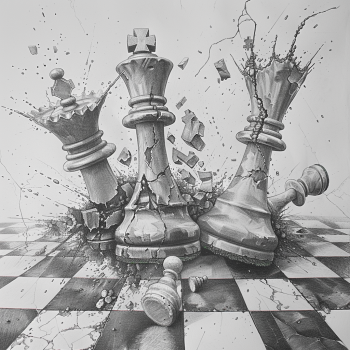Hi everyone!
Today we will talk about material advantages in chess. An advantage is one of the factors in a position that can increase your chances of winning the game. Most of the time it determines the outcome of the game, but not always!
Material Advantage
The Value of the Pieces
In this position, we shall take a look at the value of the pieces. We have already seen that the queen is the strongest piece, so it will occupy the highest rank. The rook is weaker, but it is stronger than the bishop and the knight, which are roughly equal in strength. The pawn is the weakest one of the lot.
Let me now give a more exact value to each of the pieces.
Table of Values
Each piece has a value expressed in points, with a pawn being worth 1 point. The value of each piece is influenced by the number of moves it can make!
Let’s look at how many moves each piece can make.
The Knight = A Maximum of 8 Moves
How many moves a piece can make is important for its value. In the center of the board, a knight can make a maximum of 8 moves.
The Position is Decisive
The knight is a remarkable piece. On the edge of the board, its choices are limited, and in a corner even more so. A knight in a corner can only make two moves.
The Bishop = A Maximum of 13 Moves
A bishop in the center of the board can move to many more squares than a knight can. Its maximum is 13. At the edge of the board, the bishop is much less mobile. The bishop on c1 can reach 7 squares. A bishop in the corner or on the edge can only ever reach 7 squares.
The Rook = A Maximum of 14 Moves
On an empty board, a rook can make 14 moves from any square.
What is unique about the rook is that it can go to 14 possible squares on an empty board, even if it is in a corner.
The Queen = A Maximum of 27 Moves!
The queen can move to no less than 27 different squares. That is the reason why it is, by far, the strongest piece. On our scale of values, it gets 9 points.
Each piece has its value, expressed in points, with 1 point being the value of a pawn.
The Scale of Values for the Pieces is:
The pawn = 1 point
The knight = 3 points
The bishop = 3 points
The rook = 5 points
The queen = 9 points
The queen is roughly twice as strong as a rook. It can do a lot more, and so that is fair. The rook is worth more than a bishop. It can do more and it can go to both white and black squares. At first glance, it seems comical that the bishop and the knight are roughly equal in value. The bishop can cover many more squares in a single move. But it gets a few minus points because it can only ever work on squares of a single color. The knight deserves an extra point because it is the only piece which can jump over another piece. The pawn is only worth one point.
Exchanging
When you are able to capture a protected piece, it is important to know the value of pieces. Then you can tell if it is a good idea or not.
There are two pieces the white bishop can capture here.
Exchanging Pieces of Equal Value
Exchanging pieces which are worth the same is a level exchange. Neither player loses points.
On the left, White can exchange rooks: a rook exchange. In the center, the queens can be exchanged: a queen exchange. On the right, the knights can be exchanged: a knight exchange.
Pieces of Equal Value
A bishop and a knight are each worth three points. So, knight takes bishop (left) or bishop takes knight (right) is an exchange of pieces of the same value.
Exchanging Pieces of Unequal Value
The pawn can capture the queen. The pawn is lost, but the number of points won is considerable.
Advantageous Exchange
Two examples of an advantageous exchange.
On the left, White wins 4 points by taking the queen.
On the right, the pawn takes the knight. After the recapture, the gain is 2 points.
The Exchange
On the right and on the left of the diagram, you can see the most frequently encountered advantageous exchange. A bishop or a knight captures a rook. In both cases, there is a gain of two points.
We call this swap winning the exchange.
In both halves of the board, White wins the exchange if he captures the rook.
The King Has “No Value”
The king is in check. It cannot take the bishop and neither can it allow itself to be taken. So there can never be an exchange. That is the reason why the king is not on the table of points at all (though it is the most valuable piece of all!).
Summing Up
When you are playing, it is useful to know roughly the value of the different pieces. The pieces with the most possibilities are worth the most. So the queen is worth more than the other pieces, 9 points. The rook (5 points), bishop and knight (each 3 points) are less important but still more important than the pawn (1 point).
Exchanging is the name for the capturing and recapturing of pieces. If you gain points in exchange, that is called an advantageous exchange. You cannot exchange the king, so it has no value in points.




